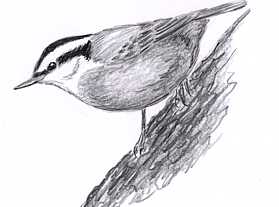
Dear Bird Folks:
A year or two ago, we had tons of Red-bellied Nuthatches in our yard and coming to our feeders. This year I’ve seen very few. Has anything happen to them? I hope not, I really enjoy those cute birds.
-Philip, W. Dennis
First Thing Philip,
It is Red-“breasted” Nuthatch, not “red-bellied”. I hate to sound like Mr. Know-it-all, but it’s better that you hear it from me than have to hear about it later, out on the street. People can be so cruel when it comes to mixing up bird names. But don’t worry man, your secret is safe with me.
I agree with you Phil. (Do you mind if I call you Phil?) Red-breasted Nuthatches are adorable little birds, with little being the key word. They are actually even more minute than our old pals the chickadees. Yet this tiny bird, which doesn’t weigh much more than a marshmallow, can somehow live through our tough New England winters. And not only is this sprite of a bird tough, it is rather unique amongst its other fellow nuthatches, which are all odd birds to begin with.
Like many birds, nuthatches earn their living by finding insects hiding under the bark of trees. However, nuthatches look for food by climbing down the tree trunk headfirst. Why would a bird want to forage for food upside-down? Well, they don’t do it just to show off, although I’m sure that’s part of it. By viewing the tree trunk from a different angle, nuthatches are able to find insects hiding under the bark that conventional foraging birds may have missed. Sometimes it pays to think outside the trunk.
They also hide food. Nuthatches will stash extra bits of food in cracks in a tree for later feeding. The clever nuthatch keeps a little extra grub on hand for emergencies, much like a three year old kid will keep snacks hidden between the cushions of the couch. Or maybe that’s just my kids that do that.
Much of the Red-breasted Nuthatch’s diet is made up of these tiny hidden insects, while the balance of their diet is seeds. When seeds are in short supply these little nuthatches do something that most other nuthatches don’t do, they pack-up and head south.
In the winter Red-breasted Nuthatches depend heavily on pine cone seeds. Every few years the pine cone crop fails and the birds move out in large numbers called an “irruption”. Areas of the country that don’t regularly see Red-breasted Nuthatches, are suddenly treated to flocks of them.
I, too, remember the irruption of Red-breasted Nuthatches that we had not too long ago. For nearly a week the trees in my yard seemed to be full of them. It was nice to step outside every morning to hear the bird’s comical, one note, nasal call coming from all around the yard. It was nice, until the ever present sound of my neighbor’s leaf blower drowned them out.
It was this irruption that you witnessed Phil. Seeing “tons” of nuthatches is unusual, seeing one or two is the norm. Usually we only get one or two nuthatches at our feeders at a time, as they can be rather territorial. Still, seeing only one of these birds can be very entertaining. Red-breasted Nuthatches are very friendly birds that will happily come to your feeder, and if you aren’t too scary looking, they might also eat right out of your hand.
Once taking a seed, the bird will fly off to “hatch” it. The nuthatch’s bill is not designed to snap open seeds like a cardinal’s. Also its weird, tree-climbing feet can’t hold a seed to crack it open, the same way a chickadee does. So the nuthatch must fly off to jam the seed into a crevice of a tree. Once the seed is lodged in the tree, the bird will smack it open with its pointy bill.
I’m not sure when the next mass invasion of nuthatches will come our way, it could be this year or next. But whenever it happens, their visit will be only temporary. Eventually they will move on out and we won’t hear their odd chorus of calls for another few years. It’s too bad I couldn’t say the same thing for my neighbor’s leaf blower.